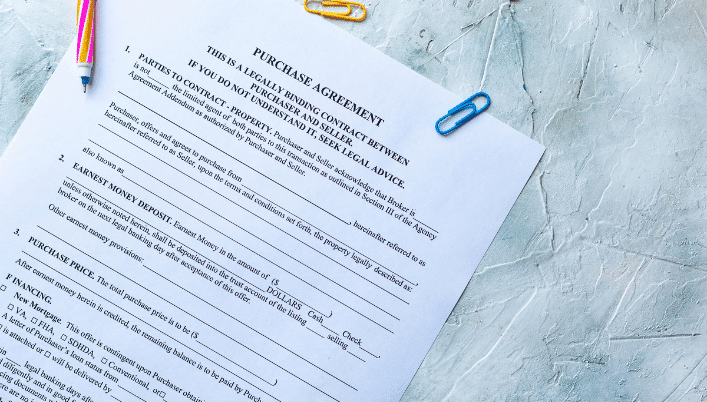What is a Sales and Purchase Agreement (SPA)?

A Sales and Purchase Agreement (SPA) is a legally binding document that defines the terms and conditions of a sale between a buyer and a seller.
It outlines the rights and obligations of both parties and serves as a reference point in case of disputes.
Let’s examine the key elements and importance of a sales and purchase agreement.
Definition of a Sales and Purchase Agreement (SPA)
A sales and purchase agreement, commonly known as an SPA, is a document that facilitates the sale of a product or service.
It is a legally binding contract that sets out the terms and conditions that both parties agree to abide by, ensuring a smooth and transparent transaction.
The SPA outlines the purchase price, payment terms, warranties, liability, conditions precedent, and other important details.
It is essential to comply with disclosure requirements and address potential risks to protect the interests of both parties.
Elements of a Sales and Purchase Agreement (SPA)
The key elements of a sales and purchase agreement include the purchase price, payment terms, warranties, liability, conditions precedent, and breach of warranty.
The purchase price defines the agreed monetary value of the transaction, while payment terms outline how and when the payment will be made.
Warranties ensure that the seller guarantees the quality, authenticity, and condition of the product or service.
The agreement also addresses liability and provides remedies for breaches of contract.
Importance of a Sales and Purchase Agreement (SPA)
A sales and purchase agreement holds great importance in any transaction.
Firstly, it ensures compliance and approval from relevant authorities, allowing for a smooth and legal process.
It provides peace of mind to both the buyer and seller, as the terms and conditions are clearly documented and legally binding.
The SPA is a crucial stage in building trust between both parties and serves as a reference point for any disputes that may arise.
It also outlines the transaction particulars, facilitating due diligence exercises and protecting the rights and interests of the parties involved.
https://www.youtube.com/watch?v=WD-lF6ywtX8
In conclusion, a sales and purchase agreement is a crucial legal document that sets out the terms and conditions of a sale.
It defines the rights and obligations of both buyer and seller, ensuring transparency and protection.
By understanding the definition, elements, and importance of an SPA, individuals can navigate sales transactions with confidence and peace of mind.
Key Takeaways
- Definition of SPA: A Sales and Purchase Agreement (SPA) is a legally binding document that outlines the terms and conditions of a sale, serving as a reference point in case of disputes.
- Elements of SPA: Key elements of an SPA include the purchase price, payment terms, warranties, liability, conditions precedent, and breach of warranty.
- Importance of SPA: SPAs ensure compliance, approval from authorities, peace of mind, trust-building, and serve as references in case of disputes.
- Legal Requirements: Legal requirements for SPAs in Singapore include regulatory approvals, due diligence, and disclosure of relevant information.
- Common Legal Issues: Legal issues may include financing, disputes over representations, and the diligence period. These should be addressed in the SPA.
- Tips for Drafting: Engaging legal professionals, addressing dispute resolution, transparency, and disclosure requirements, and specifying regulatory approvals are important when drafting an SPA.
- Complex Transactions: For complex transactions like mergers and acquisitions, an SPA is crucial, outlining assets, purchase price, payment terms, conditions precedent, indemnification, dispute resolution, and more.
- Essential Elements: An SPA for complex transactions should include clear asset/share descriptions, purchase price, payment terms, conditions precedent, indemnification, and dispute resolution mechanisms.
- Common Drafting Mistakes: Avoid common mistakes like inadequate due diligence, unclear or incomplete representations and warranties, lack of non-competition and confidentiality provisions, and insufficient termination and remedies.
Key Terms and Conditions in a Sales and Purchase Agreement (SPA)

Purchase Price
The purchase price is the agreed monetary value that the buyer will pay the seller for the product or service.
This includes any adjustments that may be agreed upon, such as for building permits or construction stages.
It also covers the agreed-upon deposit and the payment methods that will be used.
Clearly defining these terms in the SPA ensures transparency and avoids any confusion or disputes later on.
Payment Terms
The payment terms outline how and when the payment will be made.
This includes the conditions for making the initial deposit, any additional payment installments, and the timeframe for completing the full payment.
The contract must be legally enforceable, ensuring that both parties are bound by their obligations.
It is important to specify the number of business days within which payments should be made and any penalties for late payments.
Clear payment terms protect the rights of both the buyer and the seller and facilitate a smooth transaction.
Conditions Precedent
Conditions precedent refers to certain conditions that must be met before the contract becomes binding and enforceable.
This may include obtaining regulatory or governmental approvals, satisfying building specifications, or conducting building inspections.
These conditions help prevent potential disputes and ensure that both parties are comfortable proceeding with the transaction.
By addressing these conditions in the SPA, the parties can build trust and confidence in the agreement.
Warranties
Warranties are assurances provided by the seller regarding the quality, authenticity, and condition of the product or service being sold.
These warranties protect the buyer from potential liabilities and provide recourse in case of breaches of contract.
It is important to clearly define the scope and duration of warranties and outline the potential legal requirements.
Breaches of warranties could result in potential liabilities and damages, so it is crucial to address these matters in the SPA to protect the interests of both parties.
Indemnification
Indemnification provisions protect both parties from potential liabilities arising from breaches of contract or other disputes.
If one party breaches its obligations and causes harm to the other party, indemnification ensures that the responsible party takes responsibility for the consequences.
This provision provides assurance and confidence to both parties, knowing that they will not bear undue risk or loss.
Including indemnification provisions in the SPA helps build trust and ensures that potential risks are adequately addressed.
https://www.youtube.com/watch?v=uSpWwqucDhQ
In conclusion, a Sales and Purchase Agreement (SPA) in Singapore encompasses various key terms and conditions that protect the interests of both the buyer and the seller.
By clearly defining the purchase price, payment terms, conditions precedent, warranties, and indemnification provisions, the SPA ensures transparency, avoids disputes and builds trust between the parties involved.
It is essential to engage legal professionals when drafting or reviewing an SPA to ensure compliance with legal requirements and protect the rights of both parties.
Sales and Purchase Agreements in Singapore

Legal requirements for SPAs in Singapore
When entering into a Sales and Purchase Agreement (SPA) in Singapore, it is important to understand the legal requirements that govern such transactions.
These requirements ensure that the agreement is legally enforceable and protects the rights and interests of both the buyer and the seller.
In Singapore, SPAs are subject to various laws and regulations.
They may require regulatory approvals, such as obtaining permits or licenses from relevant authorities.
It is crucial to comply with these requirements to ensure that the transaction is valid and recognized by the law.
Additionally, both parties must conduct a due diligence exercise to ensure that all necessary disclosures and documentation are provided.
This includes disclosing any material contracts, financial statements, and relevant information that could affect the transaction.
The SPA should also clearly stipulate the transaction terms, including the purchase price, payment terms, and any conditions precedent that need to be fulfilled before the agreement becomes binding.
Common legal issues in SPAs in Singapore
While SPAs aim to facilitate a smooth transaction, legal issues may arise that could lead to disputes and potential liabilities.
Some common legal issues include financing arrangements, disputes over representations and warranties, and the diligence period.
It is essential to address these potential issues in the SPA to protect the rights and interests of both parties.
This could involve stipulating relevant rights and remedies in case of breaches, addressing potential disputes through arbitration or mediation clauses, and ensuring that the terms are unambiguous.
Tips for drafting and negotiating a SPA in Singapore
To navigate the process of drafting and negotiating an SPA in Singapore, it is advisable to engage legal professionals who specialize in contract law.
They can provide guidance on legal requirements, help build trust between the parties, and ensure compliance with regulations.
During the negotiation process, it is important to consider potential disputes and provide for dispute resolution mechanisms.
This could include stipulating a mitigation process or seeking approval from relevant authorities for certain aspects of the transaction.
Transparency and disclosure requirements are also crucial in building trust between the parties.
Both the buyer and the seller should provide all relevant information and documentation to ensure a fair and informed transaction.
In conclusion, entering into a Sales and Purchase Agreement in Singapore involves complying with legal requirements, addressing potential issues, and ensuring transparency and disclosure.
Engaging legal professionals and following these tips can help facilitate a smooth transaction and protect the rights and interests of both parties involved.
How to Draft a Sales and Purchase Agreement (SPA)

Essential elements of an SPA draft
Drafting a Sales and Purchase Agreement (SPA) can be a complex process that requires careful consideration of various factors.
An SPA is a legally binding document that outlines the terms and conditions of a transaction between a buyer and a seller.
Here are some essential elements that should be included in an SPA draft:
- Payment terms: The agreement should specify the purchase price and the payment terms, including the timeline for payment and any applicable interest or penalties for late payment.
- Relevant documents: The SPA should reference any relevant documents that are integral to the transaction, such as financial statements, material contracts, or regulatory approvals.
- Conditions precedent: The agreement may include conditions that need to be fulfilled before the agreement becomes binding, such as obtaining regulatory approvals or conducting due diligence exercises.
- Building trust: The SPA is a crucial stage in the transaction, and it is important to establish trust between the parties. Including provisions for confidentiality, dispute resolution mechanisms, and warranties can help build trust and minimize potential disputes.
Common drafting mistakes to avoid
When drafting an SPA, it is important to avoid common mistakes that could lead to legal issues or disputes.
Some common drafting mistakes to avoid include:
- Breach of contract: Failing to specify the rights and responsibilities of each party and the consequences for breaching the agreement can lead to misunderstandings and potential legal disputes.
- Specific covenants and conditions: It is important to include specific covenants and conditions that are relevant to the transaction. This can include provisions for non-compete agreements, intellectual property rights, or the transfer of assets.
- Legal title: Ensuring that the legal title of the assets being transferred is accurately represented in the agreement is crucial to avoid any future disputes.
- Approval and disclosure requirements: Compliance with regulatory approvals and disclosure requirements is essential. Failing to address these requirements in the SPA can lead to legal consequences and delays in the transaction.
Tips for drafting a clear and concise SPA
To draft a clear and concise SPA, consider the following tips:
- Ensure a binding contract: Clearly state that the agreement is intended to be legally binding and enforceable.
- Include payment terms: Clearly outline the payment terms, including the method and timing of payment.
- Consider crucial stages: Address any crucial stages in the transaction, such as the delivery of goods or completion of services.
- Address disclosure requirements: Include provisions for the disclosure of relevant information and documents to ensure a fair and informed transaction.
- Build trust: Include provisions that foster trust between the parties, such as confidentiality clauses, dispute resolution mechanisms, and warranties.
- Consider regulatory approvals: Address any regulatory approvals or permits that may be required for the transaction.
- Negotiation process: Clearly outline the negotiation process and any approval requirements for specific aspects of the transaction.
In conclusion, drafting a Sales and Purchase Agreement (SPA) requires careful consideration of essential elements, avoiding common drafting mistakes, and following tips for clarity and conciseness.
Engaging legal professionals can provide guidance and expertise in navigating the complexities of drafting an SPA in Singapore.
Sales and Purchase Agreements for Complex Transactions

When it comes to complex business transactions, a well-drafted Sales and Purchase Agreement (SPA) is crucial.
In Singapore, the drafting of an SPA requires careful consideration of various factors to ensure a smooth and legally binding transaction.
Here, we will explore the importance of an SPA in complex transactions, discuss essential elements that should be included, and highlight common drafting mistakes to avoid.
The Importance of an SPA in Complex Transactions
In complex transactions, such as mergers and acquisitions or joint ventures, an SPA plays a vital role in outlining the terms and conditions of the transaction.
It provides clarity and protection for both the buyer and the seller by clearly defining their rights, responsibilities, and obligations.
An SPA helps to minimize potential misunderstandings, disputes, and legal issues that may arise during and after the transaction.
Essential Elements of an SPA
When drafting an SPA for complex transactions, it is essential to include the following elements:
- Clear Description of Assets/Shares: The agreement should provide a detailed description of the assets or shares being transferred, including any warranties and representations related to their legal title and condition.
- Purchase Price and Payment Terms: The SPA should clearly state the purchase price and the agreed-upon payment terms, including any provisions for payment milestones, earn-outs, or adjustments based on financial performance
- Conditions Precedent: The agreement may include conditions that need to be fulfilled before the transaction becomes binding, such as obtaining regulatory completion due diligence exercises, or securing financing.
- Indemnification and Limitation of Liability: Including provisions for indemnification and limitation of liability protects both parties from potential risks and losses arising from breaches of warranties, misrepresentations, or other liabilities.
- Dispute Resolution Mechanisms: An SPA should outline the methods for resolving disputes, such as through negotiation, mediation, or arbitration, to minimize potential legal battles and ensure a more efficient resolution process.
Common Drafting Mistakes to Avoid
To avoid potential legal issues and disputes, it is crucial to steer clear of common drafting mistakes when preparing an SPA for complex transactions:
- Inadequate Due Diligence: Failing to conduct thorough due diligence can lead to undisclosed risks or liabilities, potentially jeopardizing the transaction.
- Unclear or Incomplete Representations and Warranties: Neglecting to include comprehensive and accurate representations and warranties could result in misunderstandings or disputes regarding the condition of the assets or shares.
- Lack of Non-Competition and Confidentiality Provisions: Omitting non-competition and confidentiality provisions can leave both parties vulnerable to competition from the other party or the disclosure of confidential information.
- Insufficient Termination and Remedies: Failing to include specific termination rights and remedies in case of breaches or failures to fulfill conditions precedent can complicate the resolution process or leave one party without appropriate recourse.
Conclusion
In conclusion, the sales and purchase agreement (SPA) is a crucial legal contract that solidifies the transaction between a buyer and a seller of real estate in Singapore.
This agreement is a legally binding document that outlines the terms and conditions of the purchase, ensuring that both parties are protected throughout the process.
The SPA serves to protect the interests of both the buyer and the seller.
It contains important details such as the agreed-upon price, the closing date of the transaction, and any contingencies or stipulations related to the transaction.
It also outlines the rights and responsibilities of both parties, ensuring clarity and transparency.
One key aspect of the SPA is the valuation of the property.
This is done to determine the fair market value of the property and can be influenced by factors such as market conditions, demand and costs related to the transaction, and the value of the inventory associated with the property.
The valuation ensures that the agreed-upon price is fair and reflects the true value of the property.
The SPA also allows for adjustments to be made under certain circumstances.
These adjustments may include changes in the purchase price based on specific events or market conditions.
It is important for both the buyer and the seller to carefully review and negotiate these adjustment clauses to ensure fairness and clarity.
Throughout the negotiation process, non-disclosure agreements may be used to protect sensitive information related to the transaction.
These agreements prevent the disclosure of confidential information to third parties and help maintain the privacy and integrity of the transaction.
If either party wishes to terminate the agreement, the SPA should outline the circumstances and procedures for doing so.
This provides a clear understanding of the rights and options available to both parties in case the need arises.
Overall, the SPA is a comprehensive document that encompasses various aspects of the purchase and sale of real estate in Singapore.
It protects the interests of both the buyer and the seller and provides a framework for the smooth and successful completion of the transaction.
It is crucial for both parties to fully understand the terms and conditions of the SPA before signing and to seek legal advice if needed.
When entering into a sales and purchase agreement in Singapore, it is essential to ensure that all parties involved fully understand their rights and obligations.
By adhering to the provisions outlined in the agreement, both buyers and sellers can navigate the complexities of real estate deals with confidence and security.
Frequently Asked Questions
What is a sales and purchase agreement?
A sales and purchase agreement (SPA) is a legally binding contract between a buyer and seller, outlining the terms of a transaction, including the sale price, purchase price adjustments, and payment terms.
What is the purpose of a sales and purchase agreement?
The purpose of a sales and purchase agreement is to establish the terms and conditions of a sale, ensuring that both parties are legally obligated to fulfill their obligations.
It helps protect the rights and interests of both the buyer and seller.
What is the purchase price?
The purchase price is the amount of money that the buyer agrees to pay to the seller in exchange for the asset or property being sold.
What is a warranty in a sales and purchase agreement?
A warranty is a provision in the sales and purchase agreement that assures the buyer that the seller guarantees certain facts about the asset or property being sold.
It protects against defects or misrepresentation.
What does it mean for a sales and purchase agreement to be legally binding?
A sales and purchase agreement is legally binding when both parties agree to the terms and conditions and sign the contract.
This means that if either party fails to fulfill their obligations, the other party can take legal action to enforce the agreement.
What is working capital in the context of a sales and purchase agreement?
Working capital refers to the difference between a company’s current assets and current liabilities.
In a sales and purchase agreement, it may be a consideration used to determine the final purchase price or the amount of money the buyer needs to operate the acquired business.
What are the conditions precedent in a sales and purchase agreement?
Conditions precedent are specific requirements or conditions that must be met before the parties are obligated to complete the transaction.
These conditions may include obtaining necessary approvals or clearances, or other milestones that need to be achieved.
What is indemnification in a sales and purchase agreement?
Indemnification is a provision in a sales and purchase agreement that allows one party to be compensated for any losses, damages, or liabilities incurred as a result of the transaction.
It provides financial protection to the party that suffers harm or loss.
What are some common legal issues in sales and purchase agreements?
Common legal issues in sales and purchase agreements include disputes over the purchase price adjustments, breach of warranties, failure to fulfill conditions precedent, and disagreements regarding indemnification or other contractual provisions.
What is net debt in the context of a sales and purchase agreement?
Net debt is the total debt of a company minus its cash and cash equivalents.
In a sales and purchase agreement, the net debt may be considered when determining the final purchase price or as a factor in calculating the value of the target company.
What are the payment terms in a sales and purchase agreement?
The payment terms in a sales and purchase agreement specify the schedule and method by which the buyer will make payments to the seller.
It outlines the amount, due dates, and any other relevant details related to the payment process.












